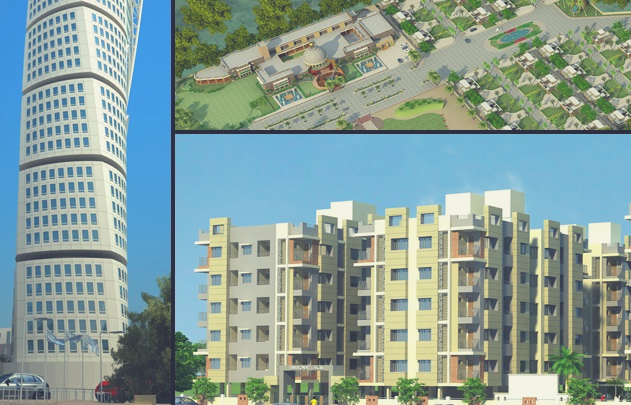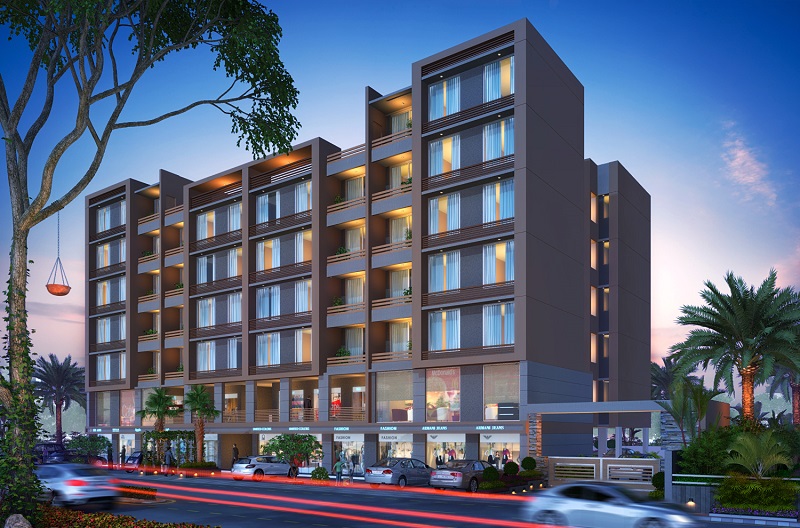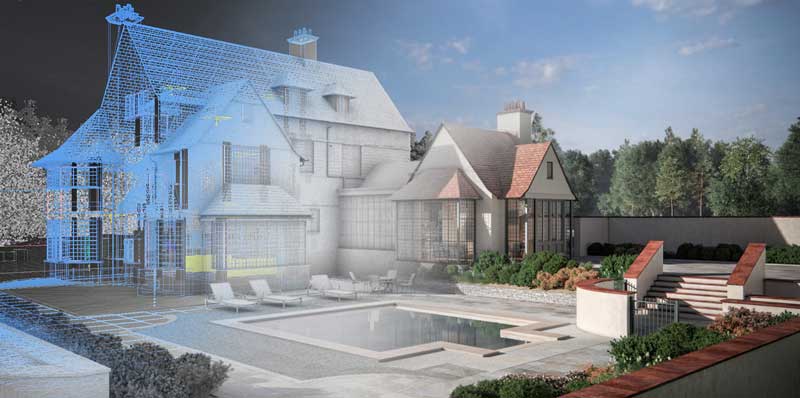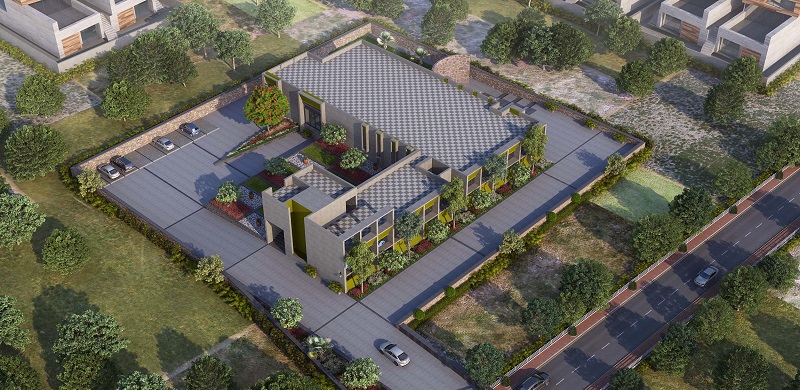Although a relatively recent development in the field of design and architecture, 3D rendering feels like it’s been around a long time. 3D rendering has found a home in many industries and has proven to be adaptable to trends and market demands.
As a tool for architects and the interior design industry, it can have many benefits, such as:
- Better engaging clients in an idea with a dynamic presentation
- Demonstrating relevance and up to date skills to a client
- Providing stand out visuals when entering design competitions
To retain these benefits, architects and 3D rendering services need to stay ahead of the curve. That’s why it’s important to understand the trends across the market.

In this article, we’ll explore different elements that make up where the market is headed in regards to 3D rendering and architectural visualization. We’ll cover:
- Business trends
- Market analysis
- Emerging techniques
- Trends in visualization
- A look into the future
With an exploration of the background of these elements and a deep dive into the benefits that designers, architects and CAD services experts can find in different options that are opening up to them.
Business Trends in 3D Rendering and Visualization
It seems that everything is going 3D, from movies and computer games to medical technology. There is a proven consumer demand on the street for all things 3D, and customers are wanting the experience to become interactive too.
Where the market leads, designers, mechanical engineers, architects, and even film producers must follow. The demand for 3D content by normal consumers is evident in the sales figures of the popular virtual reality (VR) headsets. According to Statista, nearly six million VR units were shipped in 2019, as compared to less than four million just two years earlier.
This is, of course, only looking at consumer products being sold, yet it illustrates demand for the technology that drives 3D rendering and visualization to keep improving. Indeed, the 3D rendering market is expected to grow overall to $5.63 billion by 2025, with an annual growth rate of 22.5% over that time. This figure includes the whole market.
Drivers of Growth
The market is undoubtedly there for a move towards 3D rendering and visualization, but what is causing the push to happen now? There are a range of reasons that can explain why it seems that everything is moving towards 3D renders and visualization, and why you need to be keeping pace with the developments in the industry.

Connectivity
Making 3D images and animations is data-heavy. Your computers are going to need a lot of processing power and to be able to work collaboratively, you will need some hefty data speeds. Working across a country or even continents means you need to be able to send big files fast, and the increasing speed of computer processors and the internet is making this much more feasible.
The need for 3D rendering has also become more international. Once the preserve of high-end American and European markets and developers, multi-billion-dollar property developments in the Middle East and Asia are demanding their visualizations be up to scratch with their western counterparts. Because the world is more connected, the demand for the same standards across nations is increasing.
Technological Innovations
You’d have to have been living in the middle of the Pacific for fifty years to not understand the exponential improvements in computing that have happened. Processors are getting faster, which reduces the time it takes to render an image, and computers can run code-heavy programs with ease.
Software has come a long way when it comes to 3D rendering. It’s easy to chart the changes through the movies we watch, and the advances in motion pictures have been reflected in other industries using the technology. The companies developing the technology have tapped into the needs of users and are making things more user-friendly and intuitive.
As technology gets faster and better, so does the production of images. Where it could take days to produce a 3D visualization of a housing development just a few years ago, the tools of today mean it can take mere hours.
Technology isn’t going to start regressing; 3D rendering is only going to get better, faster, and more cost-effective going into the future.
Developing Markets
The accessibility of technology has made markets more sophisticated. Consumers are demanding the best and latest technologies and quick, such as 4K quality and 3D. Designers and architectural design services have no choice but to meet market demand and keep their skills and technology up to date.
New areas that can use the skills of talented designers are also driving the market to expand and adapt. For example, in medicine, 3D visualization is being harnessed to train doctors and surgeons using real-time models of the human body. As more applications for 3D rendering come online, more skills will be needed and the software is going to develop too.
The Market in the USA
As mentioned, predictions are that there is going to be 20+% annual growth in the market in the USA for 3D visualizations and rendering. Currently, software makes up about 75% of the sector, and the big players are mainly based in the States.
The biggest companies making the tools to enable 3D rendering and visualization include:
- The Foundry Visionmongers
- Corel Corporation
- Trimble
- Autodesk
- Chaos Software
- Luxion Inc
- Adobe Systems
- Dassault Systems
With a large and diverse market, there is a lot of innovation, which is great news for the development of the market. There are a healthy number of mergers and acquisitions within the field that is also a good sign the market is dynamic.
As well as off the shelf software, the cloud market for rendering and visualization is set to grow. Being able to put an animation or design on the cloud means there can be collaborative input and also more impressive presentations to clients with walkthroughs of concepts without them having to leave their office and real-time adjustments being made. Cloud rendering services are expected to have a 24% growth rate year to year up to 2025.
Trending Techniques

Clearly, the market is big and growing for 3D rendering and visualization. There are lots of different techniques that designers and architectural 3D modelers can harness the technology to present their work to clients and hone their designs.
The primary focus of the future of the market lies in:
- Virtual reality
- Augmented reality (AR)
- Hyper-realistic rendering
And the sectors that are demanding these technologies be used are in transportation, video entertainment, and architecture.
Virtual Reality
Ensuring that the technology is keeping up with the market, the newest version of Autodesk is compatible with the Oculus Rift and HTC Vive. This is a strong indication that VR is important to the drafting services industry. These pieces of hardware are likely to see strong development away from the home entertainment and computer game markets.
Spending on content and apps for virtual and augmented reality is sent to hit eight billion by 2021. This shows the market is going to be developing strongly in this direction, and these forecasts don’t encompass hardware spending.
In terms of specific architectural applications, virtual reality has a wide range of applications that will change the landscape of what your client is going to demand. Some examples of how architects can use virtual reality are:
- Virtual tours – Architects are able to create a walk-through experience of the space that they want to create, rather than just a static drawing. The user will be able to move through space, change perspective, see what’s on the other side of the countertop, and become fully immersed in what has been created.
- Real-time rendering – This is the cutting edge of what’s possible at the moment and is set to change the whole way a 3D rendering is created. Once an architectural visualization has been created, other team members can step into the space and collaborate with voice communication via VOIP, and clients can be invited into the space without having to travel and still get a full perspective.
Augmented Reality

Although most familiar to the mainstream market as Pokemon Go or dynamic filters on Snapchat, AR has plenty of uses in architecture that are being explored and expanded upon. Although often confused or used interchangeably, AR and VR are different. AR adds computer-generated layers on top of a real image, whereas VR is a fully created, immersive image presented to the user.
The AR market can be slightly more challenging for general consumers since there is a need for something to go over your eyes to present to computerized images that are being generated. However, for a specific purpose such as architectural rendering and visualization, this isn’t a worry. There are glasses on the market that facilitate AR and you’re not asking your client to adopt them for any longer than your presentation.
A few examples of how you can apply augmented reality to your architectural process are:
- Site visualization – Clients often struggle to clearly understand your vision from a plan, or even from a virtual reality tour; not everyone is great and visualizing spaces. Using augmented reality visualizations, you can take your client to the site and show them, quite literally, in front of their eyes what you are proposing.
- Sidecut perspectives – When you have been asked to change an existing space you can overlay your ideas over the current space with side cut in 3D. This, again, will help your client in understanding what you intend to do within a realistic aspect.
Hyper-Realistic Rendering
Unlike virtual or augmented reality, your client doesn’t need any specific hardware other than a computer with a decent graphics card to be able to see your ideas. The options for hyper-realistic rendering might seem less impressive, but they are more accessible, as well as being cost-effective and quick to produce.
The move to hyper-realistic rendering is building on the trends for photorealistic design. The techniques and looks that are produced can indeed go into a virtual reality space or augmented reality presentation, but it can also stand on its own as a way to 3D render a design to present.
The big differentiator between hyper vs photorealistic rendering is the involvement of a narrative and putting emotion into the story. This can be used to further engage clients and bring a new level of understanding to the intent of the design.
To give some ideas of the applications of hyper-realistic rendering:
- 3D animation services – Everyone is familiar with animation and how they expect them to look, so moving into hyperrealism can add an extra element. An example would be an animation of a library using a cast of animated intended users to demonstrate the ways people can interact with the space.
- 3D floorplan rendering services – This is a pretty standard form of presenting a design, but in 3D, it can be manipulated and moved around so your client can understand the space. The ability to make the space look realistic is going to make things accessible to the client while not being a big cost burden. Adding elements that demonstrate ways to live in the space adds the element of hyperrealism.
- Mixed aesthetics – Architects and designers can get very attached to the way they present their designs, For example, the look of a watercolor presentation of a concept can be very eye-catching and proven to work for clients in the past. Along with hyper-realistic images, you can use software to merge in watercolor or other textures to change the visual for the client.
Modeling
In the past, you could spend days and even weeks pouring over the building of models. As materials advanced from wood to plastics, and laser cutting came along, modeling got easier. But it is still notoriously time-consuming.
A modern-day alternative to painstakingly gluing everything together comes in the form of 3D printing. It’s a technique of producing a huge array of products much quicker and has even been applied to actual house building. A design needs to be created then fed into a 3D printer and within hours, or sometimes days, a model is made.
This can be a helpful technique if you have a lot of people to explain your design to, for example, on a community project where you need to cater to a range of needs. Further, once you’ve got a model printed to scale, it can be taken as a prototype for the real thing to some degree, and you should find it easier to design the full scale, 3D printed house when you’ve already printed your scale model.
Trends in 3D Rendering Interiors

As well as being used for architectural rendering and visualization, interior designers can use 3D techniques like VR and AR to add something more to their designs. Most of the techniques discussed above apply to interiors as much as architecture, but there are new developments in where more detailed design is heading.
Lighting
Light is key to any creative process. The software that allows a designer to mock up a whole interior, or the design for one specific item, is getting better at building in and manipulating light. There are also trends towards over-lighting designs, as well as the concept of ‘Whodunnit’ lighting aesthetic. This makes a room look dark, moody, and mysterious, which may seem counter-intuitive but can add a fresh dimension to a space.
Texture
Interior items are made real by the textures that are used and tend to need to be more detailed than in an architectural visualization – these are items that a client is going to interact with so they need to be as real as possible. Marvelous Designer and VRay are both programs that are at the cutting edge of rendering and have realistic textures, with Marvelous being used by clothing designers as well.
Weather
In a similar way to lighting being played with in interior rendering, changing to weather in visualizations is a trend in the industry at the moment. Usually bright sunshine is the order of the day to show a room in its best light. By going for a cloudy atmosphere, you can buck the expectations of the client and show a fresh aspect to the design you’re presenting.
Future Demands on 3D Rendering and Visualization
The industry surrounding 3D rendering and visualizations is strong and growing. Hardware sales are buoyant, software and content are expanding, and this points to the normalization and acceptance of the medium in general.
Architects and designers need to remain relevant and stay on top of these emerging trends. Along with these areas that are developing already, there are places the market is heading that haven’t been perfected yet but should still be noted and an eye kept on them in the future.
Single Presentation Platform

There are a lot of companies in the market creating great software that is allowing these massive leaps in 3D rendering. However, with such a diverse range of technologies needed to be used, it can be tough to be able to make a smooth presentation including visualizations, tours, 3D models, followed by the business end of things like costings.
No market leader is emerging at the moment to be the go-to single platform for showing off all the work that has been done. This is an area of the market to watch since there is a large demand for such a product.
Real-Time Rendering
Although mentioned earlier, this is in its infancy. A lot of processing power is needed and advances in cloud software and storage is bringing this closer to the mainstream. Improvements in active 3D glasses are going to be the big driver in this future trend.
Being able to walk into a virtual room and make changes with others who are in the VR space is going to be game-changing. It will also allow clients to make on the spot changes, such as seeing what a change from a polished concrete the hardwood floor would look like without a massive increase in costs.
Rapid Prototyping Services
Changes in construction techniques are driving changes in how designers and architects have to work. 3D printing on a large scale means houses can be printed based on a small model. More accurate techniques for producing wall panels and steel beams mean that a 3D printed prototype can also be more necessary and much more helpful in construction than a traditional architect’s model would be.
Mixed Reality Construction
This is the cutting edge of 3D rendering and visualization and isn’t being used in the industry much at all at the moment. However, it’s where the technology is heading: a site manager calling up plans on their AR glasses and projecting the steel frame onto the space in front of them.
Holograms can also be used to demonstrate to construction workers where footings go and the angles to fit beams to, for example. An architect can send projections over to the site rather than having the workers go off paper designs, increasing accuracy and reducing error rates and therefore contingency spending on a project.
Quantum Computing
Still not perfected; those working in the field will hotly dispute exactly how far off a quantum computer might actually be. When the day of quantum computing finally does arrive, there will be plenty of changes to the world of technology and 3D rendering and visualization will indeed be affected.
With the massive requirements of processing power needed to be able to render and image, when quantum computing happens things are going to happen much quicker. This should see a decrease in costs, although the initial investment in hardware needed might not see the reduction in costs happen overnight.
Summing Up
The world of 3D rendering and visualization has changed a lot in the last few years, and the industry isn’t deep into the business cycle yet. 3D allows everyone in the process, from the designer down to the client and end-user, to be able to get a better understanding of the final product.
From the angle of how the technology will be used, the market is trending towards working in real-time, across borders. This is going to be at the design stage, with a team ‘meeting’ in the space being visualized, all the way down to construction with the plans being projected in front of the engineer to be able to place everything just so.
Cad Crowd has the pleasure of working with thousand of the best freelance 3D modeling and CAD service contractors out there. If you’re interested in working with us, get a free quote.
